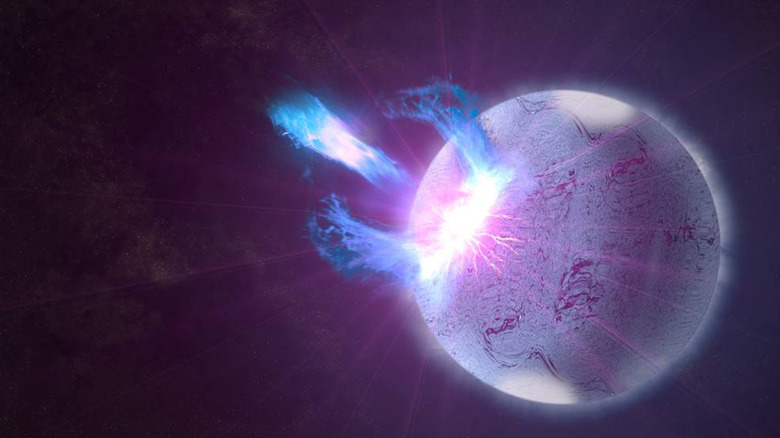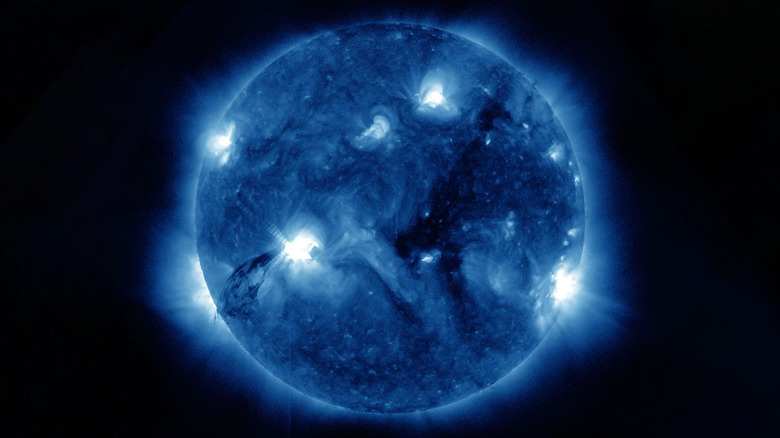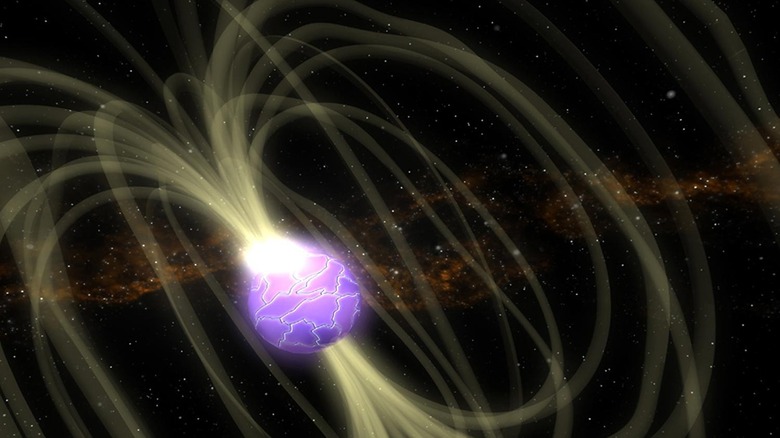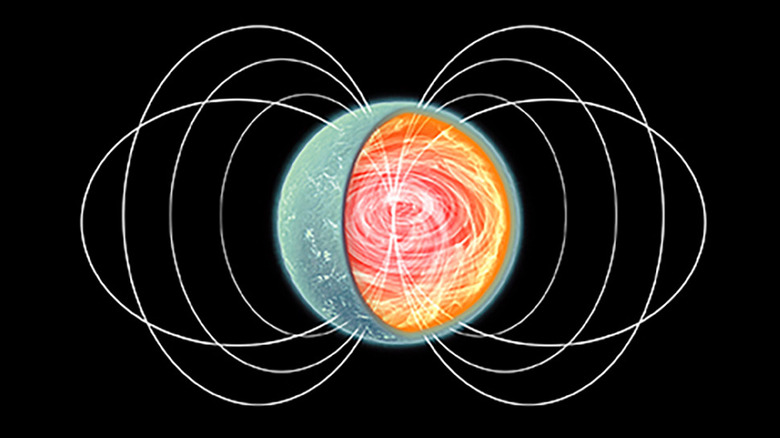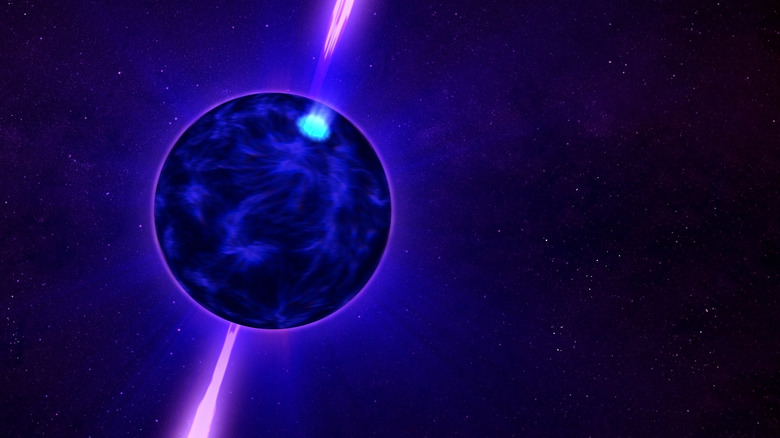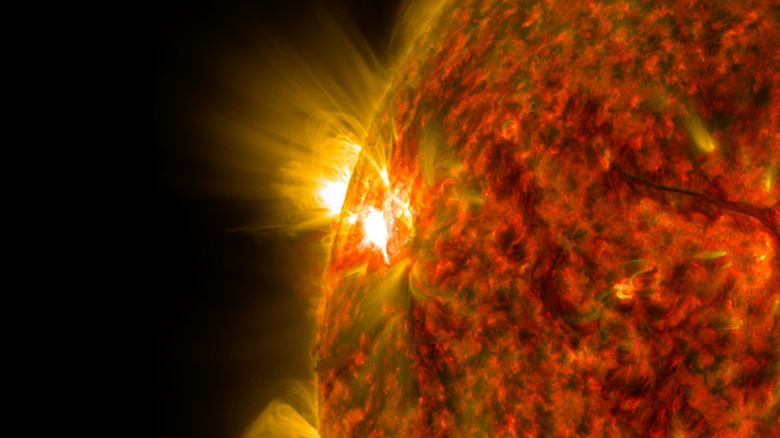The Mysterious Starquake That Rocked The Earth
Sitting here on our little rock, floating through space, spinning around the sun, it can be easy to forget that there is an entire universe out there beyond the clouds teeming with wonders and mysteries. The reason we forget about it is because from the perspective of our brief lives, the universe is constant and predictable — the cycle of the moon throughout the month or the stars throughout the year is the same for us as it was for our grandparents or their grandparents. But there are still surprises out there — surprises that can reach out and touch life on earth, leaving an indelible mark.
One such event happened in late 2004. It was over in less than a second. A massive wave of energy washed over the Earth and left a string of disabled satellites in its wake. Based on the order in which the satellites failed, scientists were able to determine the source of the blast and its likely cause: a starquake (via Scienceline).
Neutron stars
To understand what caused this massive interstellar event, we need to know a little bit about stars and how they sometimes come to form neutron stars. Stars are giant masses of gas held together by gravity. The gravity is so intense that it causes the gas atoms to fuse together, releasing massive amounts of energy. Stars, like our sun, exist in an equilibrium between the heat of fusion pushing outward and the crush of gravity pushing inward (via NASA).
Eventually, stars run out of fuel to fuse and begin to collapse as gravity overcomes the diminishing energy output of the stellar core. The gravity of these collapsing stars is so strong that it forces the atomic electrons and protons of the stellar matter in the core to fuse together, creating a neutron. If the star is big enough (four to eight times larger than our sun), these neutrons can arrest the collapse of the star, causing a supernova and creating a neutron star (via Live Science).
If you've never heard of a neutron star, its properties practically defy imagination — their density is about 10 to 14th power grams per centimeter cubed. Gravity and pressure are so strong that at some layers of the star, atoms are literally flattened (via David Darling).
Magnetars
There are a couple different types of neutron stars. The most well-known of these are pulsars. Pulsars have a crazy-fast rotational period measured in milliseconds and emit radio waves from their magnetic poles (per Scientific American). When the magnetic pole is out of alignment with the rotational pole, that beam of radio waves sweeps through the heavens like the beacon from a lighthouse. Sometimes those beams sweep across Earth and are detected as repeating radio signals. These magnetic fields can be up to ten trillion times more powerful than an average refrigerator magnet (via NASA).
Magnetars are another type of neutron star that have magnetic fields up to 1,000 times more powerful than pulsars. Scientists think this happens due to a higher internal churn of the young neutron star's innards, creating a dynamo effect powering the intense magnetic fields. One consequence of having a more powerful magnetic field is that the initially-rapid rotation of the neutron star slows down much more rapidly for a magnetar than it does for a pulsar, a fact that has helped scientists to differentiate them from their pulsar cousins (via Science).
Star crust
As newly formed neutron stars cool, a solid crust forms over the liquid core. This isn't a crust of rocks and minerals like we see on Earth — the outermost layer of a neutron star is an ultra-dense iron crystal (via Scienceline). It's one of the strongest known materials in the universe, with 10 billion times the strength of steel (per New Scientist).
But the crust isn't a homogenous skin over the core of the magnetar. As pressures mount with increasing depth, the crust is stratified into layers with different configurations of atoms and subatomic particles, eventually compressing the atoms until they are crushed into a subatomic soup of neutrons as dense as an atomic nucleus (per "Magnetars, Soft Gamma Repeaters & Very Strong Magnetic Fields"). Under the immense strain of the magnetic field, these layers grind against each other, build up stress, and break in the stellar analogue to an earthquake: a starquake (via Science).
The scale of seismic events like this is massive. It would be akin to rearranging the geology of the continental United States. The starquake from 2004 would have registered as a 32 on the Richter scale (via Discover). Comparatively, Geology.com reports that the largest recorded earthquake on Earth had a magnitude of 9.5.
The brief history of neutron stars
The existence of neutron stars was first proposed in the 1930s — shortly after the discovery of the neutron — to account for the phenomenon of supernovae (per Lumen). Three decades later, a research assistant at Cambridge University discovered a repeating radio signal. The signal was so regular that it was initially thought to be from intelligent life. After the discovery of similar signals from other places in the sky, it was clear that a new class of stars had been found: pulsars (via "Neutron Stars and Pulsars).
Around the same time, gamma-ray bursts were first observed by military satellites. For the next 10 years, scientists around the world were patiently listening, trying to puzzle out the source of the GRBs. Then, in 1979, a burst of energy 100 times more powerful than anything ever seen rushed through the solar system (via Scientific American). Scientists were able to discern its approximate origin based on when the energy burst was detected by the various Soviet and American satellites orbiting the sun, but they didn't have an explanation until 1992 (per Science).
It's dangerous out there
The massive gamma-ray burst detected in 2004 released more gamma rays than the sun emits in 150,000 years. The magnetar that spawned the energy burst was 50,000 light-years away from Earth but still temporarily knocked out the majority of satellites in the solar system (via Discover). If the eruption of energy were in our galactic neighborhood, say within 10 light-years, it would have done severe damage to our ozone layer and perhaps caused widespread blackouts across the planet (via Interesting Engineering).
Another interstellar threat is a gamma-ray burst caused by the birth of a black hole. When black holes are born, they eject twin jets of gamma rays. If such a burst were to occur 5,000 light-years from us and we were caught in its path, it would burn off our ozone layer and expose half of the planet to lethal radiation. Some scientists suspect a GRB is responsible for at least one of the mass-extinction events in our past (via Phys.org).
We're not even safe from our own star. In 1859, the Earth was struck by a large solar flare. Auroras, normally only seen in high latitudes, were seen as far south as the Caribbean (via History). The air was so charged with electricity that some telegraph machines spewed sparks and others functioned without their batteries. If the Earth were to be struck by a similar flare today, it would wipe out our power and communication infrastructure, leaving us in the dark for anywhere from a week to a year (per National Geographic).
